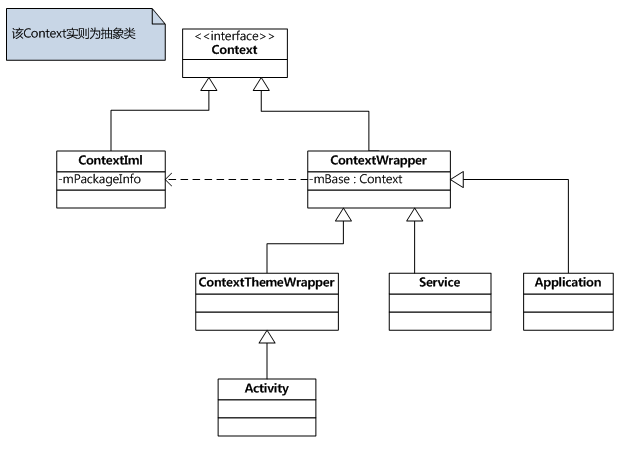一. 与Context相联系的类的继承关系如下图:

Context为抽象类,提供了一组通用的API。它的实现类为ContextImpl,该类实现了Context的功能,其大部分功能都是直接调用其属性mPackageInfo完成。
ContextWrapper类是对Context类的一种包装,该类的构造函数包含了一个真正的Context引用,即ContextImpl对象。源代码如下:
1 public class ContextWrapper extends Context{
2 Context mbase;//该属性指向一个ContextIml实例,一般在创建Application、Service、Activity时赋值
3 //创建Application、Service、Activity,会调用该方法给mBase属性赋值
4 protected void attachBaseContext(Context base){
5 if(mBase!=null){
6 throw new IllegalStateException("Base context already set");
7 }
8 mbase=base;
9 }
10 @Override
11 public void startActivity(Intent intent){
12 mBase.startActivity(intent);//调用mBase实例方法
13 }
14 }
ContextThemeWrapper类包含了主题(Theme)相关的接口,即android:theme属性指定的。只有Activity需要主题,Service不需要主题,所以Service直接继承于ContextWrapper类。
Activity类,Service类,Application类都是Context子类。
二. 什么时候创建Context实例
应用程序创建Context实例的情况有如下几种情况:
1.创建Application对象时,而且整个App共一个Application对象
2.创建Service对象时
3.创建Activity对象时
因此应用程序APP共有的Context数目个数为:
总Context实例个数=Service个数+Activity个数+1(Application对应的Context实例)
具体创建Context的时机
1.创建Application对象的时机
每个应用程序在第一次启动时,都会首先创建Application对象。如果对应用程序启动一个Activity(startActivity)流程比较清楚的话,创建Application的时机在创建handleBindApplication()方法中,该函数位于ActivityThread.java类中。源代码如下:
1 //创建Application时同时创建ContextIml实例 2 private final void handleBindApplication(AppBindData data){ 3 ...... 4 //创建Application对象 5 Application app=data.info.makeApplication(data.restrictedBackupMode,null); 6 ...... 7 } 8 public Application makeApplication(boolean forceDefaultAppClass, Instrumentation instrumentation instrumenttation){ 9 ...... 10 try{ 11 java.lang.ClassLoader cl=getClassLoader(); 12 ContextImpl appContext=new ContextImpl();//创建一个ContextIml实例对象 13 appContext.init(this,null,mActivityThread);//初始化该ContextIml实例的相关属性 14 //新建一个Application对象 15 app=mActivityThread.mInstrumentation.newApplication(cl,appClass,appContext); 16 appContext.setOuterContext(app);//将该Application实例传递给该ContextIml实例 17 } 18 ....
2.创建Activity对象的时机
通过startActivity()或startActivityForResult()请求启动一个Activity时,如果系统检测需要新建一个Activity对象时,就会回调handleLaunchActivity()方法,该方法继而调用performLaunchActivity()方法,去创建一个Activity实例,并且回调onCreate(),onStart()方法等,函数都位于ActivityThread.java类
1 //创建一个Activity实例时同时创建ContextIml实例 2 private final void handleLaunchActivity(ActivityRecord r, Intent customIntent) { 3 ... 4 Activity a = performLaunchActivity(r, customIntent); //启动一个Activity 5 } 6 private final Activity performLaunchActivity(ActivityRecord r, Intent customIntent) { 7 ... 8 Activity activity = null; 9 try { 10 //创建一个Activity对象实例 11 java.lang.ClassLoader cl = r.packageInfo.getClassLoader(); 12 activity = mInstrumentation.newActivity(cl, component.getClassName(), r.intent); 13 } 14 if (activity != null) { 15 ContextImpl appContext = new ContextImpl(); //创建一个Activity实例 16 appContext.init(r.packageInfo, r.token, this); //初始化该ContextIml实例的相关属性 17 appContext.setOuterContext(activity); //将该Activity信息传递给该ContextImpl实例 18 ... 19 } 20 ... 21 }
3.创建Service对象的时机
同过startService或bindService时,如果系统检测到需要新创建一个Service实例,就会回调handleCreateService()方法,完成相关数据操作。handleCreateService()函数位于ActivityThread.java类。
1 //创建一个Service实例时同时创建ContextIml实例 2 private final void handleCreateService(CreateServiceData data){ 3 ... 4 //创建一个Service实例 5 Service service = null; 6 try { 7 java.lang.ClassLoader cl = packageInfo.getClassLoader(); 8 service = (Service) cl.loadClass(data.info.name).newInstance(); 9 } catch (Exception e) { 10 } 11 ... 12 ContextImpl context = new ContextImpl(); //创建一个ContextImpl对象实例 13 context.init(packageInfo, null, this); //初始化该ContextIml实例的相关属性 14 //获得我们之前创建的Application对象信息 15 Application app = packageInfo.makeApplication(false, mInstrumentation); 16 //将该Service信息传递给该ContextImpl实例 17 context.setOuterContext(service); 18 ... 19 }
通过对ContextImpl的分析可知,其方法的大多数操作都是直接调用其属性mPackageInfo(该属性类型为PackageInfo)的相关方法而来。这说明ContextImpl是一种轻量级的类,而PackageInfo才是真正重量级的类。而一个App里的所有ContextImpl实例,都对应同一个packageInfo对象。
最后分析利用Context获取SharedPreferences类,一般的获取方法就是通过getSharedPreference()方法根据相关信息获取SharedPreference对象。
具体如下:
1.调用getSharedPreferences()获取对应的文件,该函数实现功能如下:
1 //Context类静态数据集合,以键值对保存了所有读取该xml文件后所形成的数据集合 2 private static final HashMap<File, SharedPreferencesImpl> sSharedPrefs = 3 new HashMap<File, SharedPreferencesImpl>(); 4 5 @Override 6 public SharedPreferences getSharedPreferences(String name, int mode){ 7 //其所对应的SharedPreferencesImpl对象 ,该对象已一个HashMap集合保存了我们对该文件序列化结果 8 SharedPreferencesImpl sp; 9 File f = getSharedPrefsFile(name); //该包下是否存在对应的文件,不存在就新建一个 10 synchronized (sSharedPrefs) { //是否已经读取过该文件,是就直接返回该SharedPreferences对象 11 sp = sSharedPrefs.get(f); 12 if (sp != null && !sp.hasFileChanged()) { 13 //Log.i(TAG, "Returning existing prefs " + name + ": " + sp); 14 return sp; 15 } 16 } 17 //以下为序列化该xml文件,同时将数据写到map集合中 18 Map map = null; 19 if (f.exists() && f.canRead()) { 20 try { 21 str = new FileInputStream(f); 22 map = XmlUtils.readMapXml(str); 23 str.close(); 24 } 25 ... 26 } 27 28 synchronized (sSharedPrefs) { 29 if (sp != null) { 30 //Log.i(TAG, "Updating existing prefs " + name + " " + sp + ": " + map); 31 sp.replace(map); //更新数据集合 32 } else { 33 sp = sSharedPrefs.get(f); 34 if (sp == null) { 35 //新建一个SharedPreferencesImpl对象,并且设置其相关属性 36 sp = new SharedPreferencesImpl(f, mode, map); 37 sSharedPrefs.put(f, sp); 38 } 39 } 40 return sp; 41 } 42 }
2.SharedPreferences是个接口,它定义了一些操作xml文件的方法,其真正实现类为SharedPreferencesImpl,该类是ContextImpl的内部类,该类如下:
1 //soga,这种形式我们在分析Context ContextIml时接触过 2 //SharedPreferences只是一种接口,其真正实现类是SharedPreferencesImpl类 3 private static final class SharedPreferencesImpl implements SharedPreferences{ 4 private Map mMap; //保存了该文件序列化结果后的操作, 键值对形式 5 6 //通过key值获取对应的value值 7 public String getString(String key, String defValue) { 8 synchronized (this) { 9 String v = (String)mMap.get(key); 10 return v != null ? v : defValue; 11 } 12 } 13 ... 14 //获得该SharedPreferencesImpl对象对应的Edito类,对数据进行操作 15 public final class EditorImpl implements Editor { 16 private final Map<String, Object> mModified = Maps.newHashMap(); //保存了对键值变化的集合 17 } 18 }
以上内容转自:http://blog.csdn.net/qinjuning/article/details/7310620#